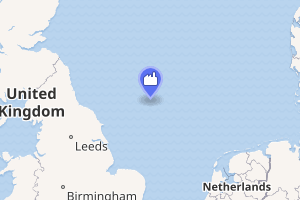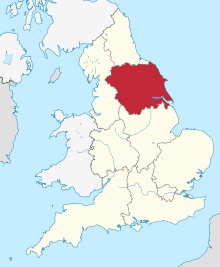Dogger Bank Wind Farm
Dogger Bank Wind Farm is a group of offshore wind farms under construction 125 to 290 kilometres (78 to 180 mi) off the east coast of Yorkshire, in the North Sea, England.[1] It is being developed by the Forewind consortium. It is expected that the Dogger Bank development will consist of four offshore wind farms, each with a capacity of up to 1.2 GW, creating a combined capacity of 4.8 GW. Planning consent for the first phase of the project (Creyke Beck A and Creyke Beck B) was granted by the UK government in February 2015, and consent for the second phase (Teesside A and Teesside B) was granted in August 2015.
| Dogger Bank Wind Farm | |
|---|---|

| |
| Country | England, United Kingdom |
| Location | Dogger Bank |
| Coordinates | 54°45′N 1°55′E |
| Status | Under construction |
| Owner(s) | Forewind (developer) |
| Wind farm | |
| Type | Offshore |
| Distance from shore | 125 km (78 mi) |
| External links | |
| Website | doggerbank |
The farms were all successful in the 2019 contract for difference auction and have a delivery date between 2023 and 2025.[2] In 2019, GE was chosen to provide the turbines for the project.[3]
Project overview
Dogger Bank is in the North Sea, located between 125 kilometres (78 mi) and 290 kilometres (180 mi) off the east coast of Yorkshire. It is one of nine offshore zones belonging to the Crown Estate which formed part of the third licence round for UK offshore wind farms.
The Dogger Bank is an attractive location for offshore wind farms because it is far away from shore, avoiding complaints about the visual impact of wind turbines, yet the water depth is shallow enough for traditional fixed foundation wind turbine designs.[4] Fixed-foundation wind turbines are economically limited to maximum water depths of 40 to 50 metres (130 to 160 ft),[5] at greater water depths new floating wind turbine designs are required, which currently cost significantly more to build.[6]
The Forewind consortium was formed by the four owner companies – SSE, RWE, Statoil and Statkraft – in November 2008 in response to the third licence round.[7] In January 2010, Forewind was announced as the developer for the Dogger Bank Zone, the largest of the Round 3 zones.[7] Statoil increases its share from Statkraft, beginning in 2017.[8] In August 2017 new ownership arrangements were announced, SSE and Equinor (formerly Statoil) have each taken 50% share in Dogger Bank Creyke Beck A, B and Teeside A, while Innogy (RWE subsidiary) has taken Teesside B and renamed it to Sofia Offshore Wind Farm.[9]
Originally projected to produce up to 9 GW of power, the plan was scaled down to 7.2 GW in 2014,[10] and scaled down even further to 4.8 GW in 2015.[11]
The wind farm is planning to use the Haliade-X 12 MW from GE, one of the world's largest wind turbines,[12] to be installed by the wind turbine installation vessel Voltaire.[13]
Dogger Bank Creyke Beck A and B
The first phase will be for Dogger Bank Creyke Beck A and B.[7] This will comprise two offshore wind farms each generating up to 1.2 GW of electricity,[14] with a total installed capacity of up to 2.4 GW.[7] They would connect to the existing Creyke Beck substation near Cottingham, in the East Riding of Yorkshire.[7] The two sites lie 131 kilometres (81 mi) from the East Yorkshire coast.[15] Dogger Bank Creyke Beck A will cover an area of 515 square kilometres (199 sq mi), and Dogger Bank Creyke Beck B will cover an area of 599 square kilometres (231 sq mi).[15] Planning consent was granted for 400 turbines on 17 February 2015.[16] These two projects are owned by SSE and Equinor.[9] ABB was chosen for the HVDC light power transfer cables to shore.[17]
Dogger Bank Teesside
Dogger Bank Teesside is intended to be the second stage of development of the Dogger Bank Zone.[18] It was divided into two phases of development: Dogger Bank Teesside A & B and Dogger Bank Teesside C & D.[19] These would connect to the National Grid at a substation in Redcar and Cleveland, Teesside.[20]
Dogger Bank Teesside
Dogger Bank Teesside A & B comprises two wind farms, each generating up to 1.2 GW of electricity.[10] Dogger Bank Teesside A lies 196 kilometres (122 mi) from the shore and will cover an area of 560 square kilometres (220 sq mi).[21] Dogger Bank Teesside B lies 165 kilometres (103 mi) from the shore and will cover an area of 593 square kilometres (229 sq mi).[21] Planning consent was granted for 400 turbines on 5 August 2015.[22] Construction of the wind farms must begin before August 2022.[23]
Since 2017 SSE and Equinor own Dogger Bank Teesside A, while Dogger Bank Teesside B was taken by Innogy and renamed Sofia Offshore Wind Farm.[9]
Dogger Bank Teesside C & D
This second application (C and D) was planned to comprise two wind farms, each generating up to 1.2 GW of electricity.[24] It was originally expected that planning consent would be determined in 2017.[24] However, in August 2015 Forewind scrapped the final phase and returned the remaining area of the Dogger Bank development zone to the Crown Estate.[11][25]
North Sea Wind Power Hub
Dutch, German, and Danish electrical grid operators are cooperating in a project to build a North Sea Wind Power Hub complex on one or more artificial islands to be constructed on Dogger Bank as part of a European system for sustainable electricity. The power hub would interconnect the three national power grids with each other and with the Dogger Bank Wind Farm.
A study commissioned by Dutch electrical grid operator TenneT reported in February 2017 that as much as 110 gigawatts of wind energy generating capacity could ultimately be developed at the Dogger Bank location.[26]
At the North Seas Energy Forum in Brussels on 23 March 2017, Energinet.dk will sign a contract to work with the German and Dutch branches of TenneT; thereafter a feasibility study will be produced.[27][28]
References
- "Forewind Dogger Bank". Forewind. 2017. Retrieved 9 June 2017.
- "Contracts for Difference (CfD) Allocation Round 3: results". 20 September 2019. Retrieved 20 September 2019.
- "GE to provide world's most powerful turbines for British wind project". Reuters. 1 October 2019. Retrieved 1 October 2019.
- Harvey, Fiona (17 February 2015). "World's biggest offshore windfarm approved for Yorkshire coast". The Guardian. Retrieved 26 July 2017.
- "Deep Water - The next step for offshore wind energy". WindEurope.org. European Wind Energy Association. Retrieved 26 July 2017.
- Martin, Richard. "Floating Wind Farms: Great Concept, Implausible Economics". MIT Technology Review. MIT Technology Review. Retrieved 26 July 2017.
- "Dogger Bank offshore zone". RWE. Retrieved 22 July 2014.
- "Statoil increases in UK offshore wind". Statoil. Retrieved 9 September 2016.
- "Dogger Bank Windfarms Newsletter" (PDF). doggerbank.com. 2018. Retrieved 8 December 2018.
- Laister, David (19 February 2014). "Dogger Bank wind farm zone to be scaled back by 20 per cent". Grimsby Telegraph. Archived from the original on 2 May 2014. Retrieved 1 May 2014.
- "Utility Week – Forewind scraps final Dogger Bank phase". utilityweek.co.uk. Retrieved 12 August 2015.
- "GE Renewable Energy's Haliade-X turbines to be used by Dogger Bank Wind Farms | GE Newsroom". www.genewsroom.com. Retrieved 29 October 2019.
- Snyder, John (11 March 2020). "New class of installation vessels to handle 'super-sized' wind turbines". Riviera Maritime Media. Retrieved 12 March 2020.
- "Dogger Bank Creyke Beck offshore wind farm plans move closer". BBC News. 25 September 2013. Retrieved 22 July 2014.
- "Dogger Bank Creyke Beck". Forewind. Retrieved 22 July 2014.
- "Government green lights record-breaking Dogger Bank offshore wind farm". businessgreen.com. Retrieved 6 August 2015.
- "HVDC technology to connect world's largest offshore windfarm to the grid". Riviera Maritime Media. 30 October 2019. Retrieved 30 October 2019.
- "Dogger Bank Teesside". Forewind. Retrieved 22 July 2014.
- "First application for Dogger Bank projects". Statkraft. 29 September 2013. Retrieved 22 July 2014.
- "Forewind development consent order application for Dogger Bank accepted by UK Planning Inspectorate". Renewable Energy Magazine. 1 October 2013. Retrieved 22 July 2014.
- "Dogger Bank Teesside A & B". Forewind. Retrieved 22 July 2014.
- "Dogger Bank wind farm plan off Teesside coast". BBC News. 5 August 2015. Retrieved 6 August 2015.
- Morales, Alex (5 August 2015). "U.K. Allows Consortium to Build Biggest Offshore Wind Project". Bloomberg.com. Retrieved 6 August 2015.
- "Dogger Bank Teesside C & D". Forewind. Retrieved 22 July 2014.
- Weston, David. "Dogger Bank Teesside C & D 2.4GW projects cancelled". www.windpoweroffshore.com. Retrieved 8 December 2018.
- "Offshore Wind Capacity Dogger Bank" (PDF). North Sea Wind Power Hub. Royal Haskoning DHV. Retrieved 26 May 2019.
- "Artificial island is planned on Dogger Bank for cheaper wind power". Sky News. 13 March 2017. Retrieved 23 March 2017.
- "First meeting of North Seas Energy Forum". European Commission. Retrieved 23 March 2017.
